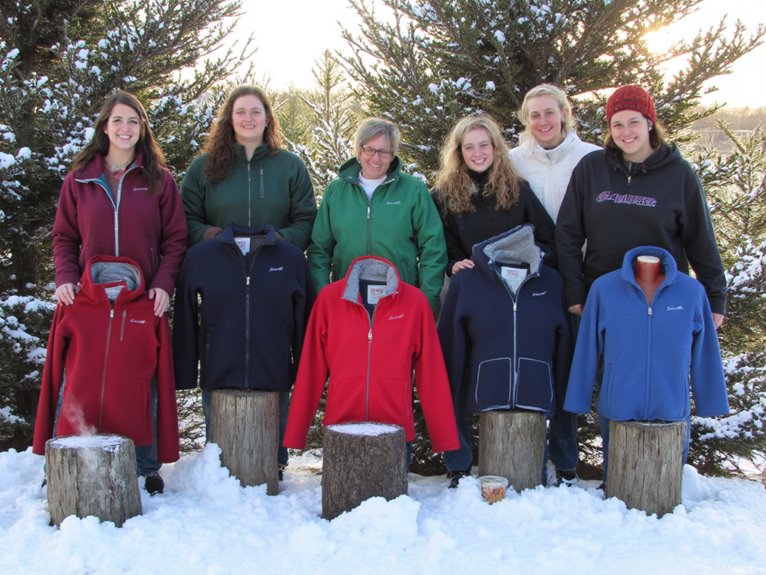How Do You Stay on Top of an Avalanche?
Staying on top of an avalanche requires a combination of knowledge, preparation, and quick thinking. Understanding avalanche dynamics, conducting pre-avalanche safety checks, and packing essential gear can substantially reduce the risk of being caught off guard. During an avalanche, maintaining a horizontal position and creating an air pocket around the mouth and nose are vital for survival. Visual signals, such as flashing light signals and emergency whistle use, can alert rescuers to one's location. By staying calm and thinking clearly, you can increase your chances of staying safe and surviving an avalanche – and there's more to learn about how to do just that.
We are supported by our audience. When you purchase through links on our site, we may earn an affiliate commission, at no extra cost for you. Learn more. Last update on 20th January 2026 / Images from Amazon Product Advertising API.
Understanding Avalanche Dynamics
Avalanches are complex, multifaceted phenomena governed by intricate interactions between snow, terrain, and weather, making it essential to grasp the underlying dynamics to stay ahead of these powerful forces of nature. Understanding avalanche dynamics is imperative for predicting and mitigating the risks associated with these natural disasters. The combination of snowpack instability, slope angle, and weather conditions can trigger an avalanche, and recognizing these factors is essential for safe navigation in avalanche-prone areas. By recognizing the warning signs, such as recent snowfall, strong winds, and changing temperatures, individuals can take proactive measures to avoid hazardous situations. A solid understanding of avalanche dynamics empowers individuals to make informed decisions, minimizing the risk of being caught off guard by these destructive forces.
Pre-Avalanche Safety Checks
Before venturing into avalanche-prone terrain, it is crucial to perform a series of pre-avalanche safety checks to identify potential risks and take proactive measures to minimize the threat of being caught off guard. Conducting a thorough assessment of weather conditions, including temperature, wind direction, and snowfall, helps anticipate potential avalanche triggers. Inspect your equipment, verifying that it is in good working order, and that you have a functioning avalanche transceiver, probe, and shovel. Additionally, evaluate your group's experience level, physical condition, and equipment to confirm everyone is prepared for the terrain. By taking these essential steps, you can substantially reduce the risk of being caught in an avalanche and increase your chances of staying safe.
Staying Afloat During Chaos
When the unexpected happens and an avalanche is triggered, staying calm and relying on your training, experience, and equipment becomes vital to survival. Panic can lead to poor decision-making, which can be fatal. In the chaos of an avalanche, it's essential to focus on your breathing, assess your situation, and prioritize your actions.
To stay afloat during chaos, remember:
- Stay calm and think clearly: Avoid impulsive decisions and focus on your next move.
- Conserve energy: Avoid exhausting yourself, as you'll need energy to escape or wait for rescue.
- Maintain a positive mindset: Believe in your ability to survive, and visualize a successful outcome.
Essential Gear for Survival
Equipped with the right gear, you'll substantially increase your chances of survival in an avalanche scenario. A transceiver, probe, and shovel are essential items to carry with you whenever you're venturing into avalanche terrain. A transceiver helps rescuers locate you, while a probe and shovel enable you to dig yourself out if buried. Wear a helmet to protect your head from impact, and consider a backpack with built-in avalanche safety features, such as an integrated airbag or inflatable vest. Additionally, carry an avalanche transceiver, which helps you detect the signal of a buried person. By packing these critical items, you'll be better equipped to respond effectively in the event of an avalanche.
Positioning Your Body Correctly
Your body positioning in the face of an avalanche is crucial, as it can significantly impact your chances of survival. In the chaos of an avalanche, it's essential to maintain a strategic position to increase your chances of staying on top. Here are three key considerations to keep in mind:
- Streamline your body: Keep your arms and legs together, with your feet downhill, to reduce wind resistance and prevent being knocked off course.
- Face downhill: Look downhill to anticipate the direction of the avalanche and maintain visibility.
- Maintain a horizontal position: Keep your body parallel to the slope to minimize the risk of being swept underwater or trapped in a snowbank.
Creating an Air Pocket
Creating an air pocket around your mouth and nose is a crucial step in surviving an avalanche, as it allows you to breathe and potentially extend your survival time. To create an air pocket, use your hands to push away the snow around your face, creating a small cavity. This will allow you to inhale and exhale without sucking in snow. It's essential to remain calm and move slowly to conserve energy and avoid causing the snow to settle further. As you create the air pocket, try to position your mouth and nose in the center, allowing for maximum airflow. Remember, every second counts, and creating an air pocket can substantially increase your chances of survival.
Visual Signals for Help
When buried under snow, visual signals can be a vital means of alerting rescuers to your location. Two essential tools for visual signaling are flashing light signals and emergency whistle use, both of which can substantially increase your chances of being quickly located. By understanding how to effectively utilize these visual signals, you can greatly improve your chances of being rescued in a timely manner.
Flashing Light Signals
In the midst of an avalanche, flashing light signals can be a vital means of visually signaling for help, particularly when vocal calls for rescue are muffled by the surrounding snow. These signals can be especially effective in low-visibility conditions or when rescuers are far away. Three key considerations for using flashing light signals effectively are:
- Select the right device: Select a light source that is waterproof, durable, and visible from a distance, such as a strobe light or LED flare.
- Use it strategically: Activate your light signal in short, repetitive bursts to conserve energy and maximize visibility.
- Combine with other signals: Use flashing lights in conjunction with other visual signals, such as mirrors or brightly colored clothing, to increase the chances of being spotted by rescuers.
Emergency Whistle Use
While flashing light signals can be an effective means of visual signaling, they may not be audible from a distance, which is where emergency whistles come into play, providing a loud, piercing sound that can cut through the noise of an avalanche. In the chaos of an avalanche, a whistle's high-pitched shriek can travel far and wide, increasing the chances of being heard by rescuers. When using an emergency whistle, it's essential to blow it in short, three-second blasts, followed by a brief pause. This internationally recognized distress signal is easy to learn and can be a lifesaver in a crisis situation. By incorporating an emergency whistle into your avalanche safety kit, you're adding a crucial tool to your signaling arsenal.
Staying Calm Under Pressure
Amidst the chaos of an avalanche, staying calm under pressure is vital, as it allows you to think clearly and make rational decisions that can mean the difference between life and death. Panic can cloud your judgment, leading to reckless decisions that put you and others at greater risk. To stay calm, focus on your breathing, and try to slow down your heart rate. This will help you think more clearly and make better decisions.
Here are some tips to help you stay calm under pressure:
- Breathe deeply and slowly: This helps slow down your heart rate and calm your nervous system.
- Focus on the present moment: Avoid worrying about the future or past, and focus on what you can control in the present.
- Prioritize your safety: Remember that your safety is the top priority, and make decisions that ensure your well-being.
Post-Avalanche Response
Once you've managed to stay calm and survive the initial avalanche, your priority shifts to responding effectively in the aftermath to minimize further risk and guarantee a safe exit. Assess your surroundings, taking note of any potential hazards, such as crevasses, steep slopes, or additional avalanche threats. Quickly evaluate your physical condition, treating any injuries and addressing hypothermia or frostbite. Locate your emergency gear, including your transceiver, probe, and shovel, and prepare for a potential rescue or self-extraction. Establish communication with your group, ensuring everyone is accounted for and safe. Stay vigilant, as the post-avalanche environment can be just as deadly as the avalanche itself.




